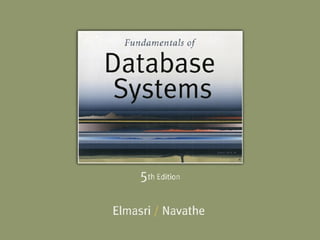The document discusses the relational algebra and calculus. It provides an overview of relational algebra operations including unary operations like select, project, and rename. It also covers binary operations from set theory like union, intersection, and difference. Examples are provided to illustrate how to express queries using sequences of relational algebra operations and how the results of operations like union, intersection and difference are computed.





































![Slide 6- 38Copyright © 2007 Ramez Elmasri and Shamkant B. Navathe
Some properties of JOIN
Consider the following JOIN operation:
R(A1, A2, . . ., An) S(B1, B2, . . ., Bm)
R.Ai=S.Bj
Result is a relation Q with degree n + m attributes:
Q(A1, A2, . . ., An, B1, B2, . . ., Bm), in that order.
The resulting relation state has one tuple for each
combination of tuples—r from R and s from S, but only if
they satisfy the join condition r[Ai]=s[Bj]
Hence, if R has nR tuples, and S has nS tuples, then the join
result will generally have less than nR * nS tuples.
Only related tuples (based on the join condition) will appear
in the result](https://image.slidesharecdn.com/chapter6-180408135143/85/Chapter6-38-320.jpg)






![Slide 6- 45Copyright © 2007 Ramez Elmasri and Shamkant B. Navathe
Binary Relational Operations: DIVISION
DIVISION Operation
The division operation is applied to two relations
R(Z) ÷ S(X), where X subset Z. Let Y = Z - X (and hence Z
= X ∪ Y); that is, let Y be the set of attributes of R that are
not attributes of S.
The result of DIVISION is a relation T(Y) that includes a
tuple t if tuples tR appear in R with tR [Y] = t, and with
tR [X] = ts for every tuple ts in S.
For a tuple t to appear in the result T of the DIVISION, the
values in t must appear in R in combination with every tuple
in S.](https://image.slidesharecdn.com/chapter6-180408135143/85/Chapter6-45-320.jpg)



































